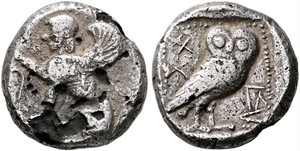Cypriot Idalion(?) subaeratus ancient fake 1/3 siglos: Classical I (450/49 BC ?)
Silver plated copper intended to simulate a silver 1/3 siglos coin. Sphinx seated to left, resting her right forepaw on a lotus tendril [with flower and bud?]. Reverse: left 𐠯𐠞 ('pa-ti') in Cypriot Syllabary, Owl standing right, head facing; lower right, uncertain (partially: ΓΔ = ‘GD’ in Greek alphabet, with ‘L”? under); all within dotted square within incuse square. Breaks in plating on the obverse, otherwise, very fine.
Unpublished and unique.
The Cypriot origin of this coin is evident not only from the coin reverse (left) legend𐠯𐠞 ('pa-ti') in Cypriot script but also from the obverse design. The seated Sphinx facing left, with her raised right forepaw above a lotus flower, is directly copied from a coin type of Stasikypros, who ruled Idalion around 460-450/445 BC, though a rather similar sphinx appears on Chian coins. The owl, on the other hand, is clearly derived from Athenian coinage, and the text to its right does not make sense as Cypriot syllabary - only the rotated V shape of ‘sa’ or ‘wo’ (or a variant of ‘go’ or ‘ko’) could be weakly identified. It is most likely Greek, clearly starting ΓΔ (= GD) with possibly an Ionic L (or V) turned sideways for lack of space. Alternatively, but less likely, the letters could be Phoenician consonants 𐤁𐤋 ‘ba-li’(?) turned 90° with lowest line unexplained. However an Athenian symbol with Cypriot and Phoenician text seems unlikely.
If it is Greek it would be easily the first appearance of Greek letters on a Cypriot coin. After this the earliest was on Salamis coins from the start of the 4th century (the E or EV of king Evagoras, again among Cypriot syllabary).
All this is remarkable, as Cyprus remained under Persian control and unlike regions such as Lycia, Philistia, and Egypt, Cypriot coinage shows no reference to the two main, widely circulating Athenian coin types, apart from the helmeted head of Athena used at Lapethos (though not in the Athenian style), and a single coin type featuring a small owl's head beneath a bull (SNG Paris 440).
It has been suggested that the explanation is the Athenian naval expedition under Kimon to the island in 450/49 BC, which resulted in a double Athenian victory on land and sea, but also in an unsuccessful siege of Kition, the death of Kimon, and the eventual withdrawal of Athenian forces from the island after the ‘Peace of Callias’. Perhaps this coin was minted as a political gesture by local Cypriot rebels. The fact that the coin is plated with foil to simulate a silver coin could suggest it was struck in times of crisis. It also suggests the conquest of Idalion by nearby Kition, usually dated around 450 or slightly earlier, was after this event, possibly as reprisal for the siege of Kition, and perhaps supported by Persia as punishment for their support of the Athenians. After this Idalion did not mint their own coins. Kition had already unsuccessfully besieged Idalion in 478 and 470 BC.
If this interpretation is correct this coin is historically important, though its limited provenance is a problem.
Cf: BMC Greek Vol.24 Pl.V.13-16; Traité II, 2, 1250 and pl. CXXXII, 7
Size: 15 mm, 3.27 g, 6 h
(Provenance: European collection, formed before 2005.)
(Aquired by DJ auction Leu Numismatic 31 May 2025)
(AN 262 DJ 282)

